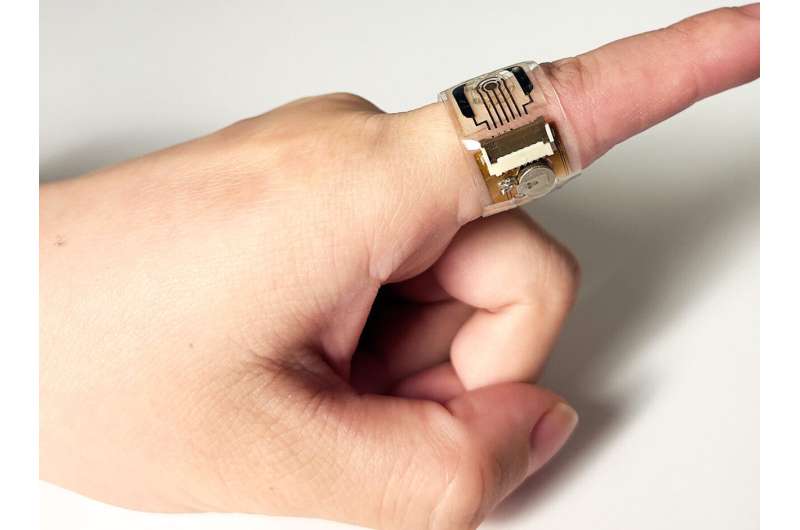The sex hormone commonly known as estrogen plays an important role in multiple aspects of women’s health and fertility. High levels of estrogen in the body are associated with breast and ovarian cancers, while low levels of estradiol can result in osteoporosis, heart disease, and even depression. (Estrogen is a class of hormones that includes estradiol as the most potent form). Estradiol is also necessary for the development of secondary sexual characteristics in women and regulates the reproductive cycle.
Because of its many functions, the hormone estradiol is often specifically monitored by physicians as part of women’s health care, but this usually requires the patient to visit a clinic to have blood drawn for analysis in a lab. Even at-home testing kits require samples of blood or urine to be mailed to a lab.
But now Caltech researchers have developed a wearable sensor that monitors estradiol by detecting its presence in sweat. The researchers say the sensor may one day make it easier for women to monitor their estradiol levels at home and in real time.
The paper describing the research, “A wearable aptamer nanobiosensor for non-invasive female hormone monitoring,” appears in the Sept 28 issue of Nature Nanotechnology.
The research was conducted in the lab of Wei Gao, assistant professor of medical engineering, investigator with the Heritage Medical Research Institute, and Ronald and JoAnne Willens Scholar. In recent years, Gao has developed sweat sensors that detect cortisol, a hormone associated with stress; the presence of the COVID-19 virus; a biomarker indicating inflammation in the body; and a whole slew of other nutrients and biological compounds.
Gao says the development of the estradiol sensor was spurred in part by requests from people who were unsatisfied with the options they had for monitoring their estrogen levels and had seen his previous work.
“People often ask me if I could make the same kind of sweat sensor for female hormones, because we know how much those hormones impact women’s health,” Gao says.

One population of women who would benefit from estradiol monitoring are those who are attempting to conceive a child, either naturally or through in vitro fertilization. The success of either method is dependent on getting timing right with regards to ovulation, but not all women have a reproductive cycle that follows a regular schedule. Some women have been able to track their ovulation by monitoring their body temperature, but Gao says that method has limited usefulness because it’s not very accurate and body temperature doesn’t increase until ovulation has begun.
“But estrogen increases before ovulation,” he says. “With this sweat sensor, we would be able to give people notice ahead of time.”
Other individuals who could benefit from a wearable estrogen sensor are those undergoing hormone replacement therapy (HRT) because their bodies do not produce sufficient estradiol. In these patients, estradiol levels need to be carefully monitored to ensure they are taking the correct dosage.
The sensor Gao’s team developed is similar in many ways to the various sensors developed by the group in the past. It is built on a flexible plastic membrane; has tiny etched passages (microfluidics) for channeling small amounts of sweat into the sensor; and inkjet-printed gold nanoparticles and titanium carbide films (known as MXenes) that give the sensor a large surface area and electrical conductivity to increase its sensitivity.
The primary challenge, and what dictated changes in the sensor’s design this time around, is that estradiol, which already is present at fairly low levels in the blood, is roughly 50 times less concentrated in sweat.
“Since it’s such a low concentration, it’s very challenging to detect estradiol automatically in sweat,” Gao says.
For the new sensor, the research team made use of short single-stranded DNA known as aptamers. Aptamers work as artificial antibodies and are designed to bind specifically to a target molecule. The aptamers are attached to a surface modified with gold nanoparticles and bind to single-stranded DNA molecules tagged with a molecule that can directly donate or accept electrons under certain conditions.
When an aptamer binds to an estradiol molecule, it releases the redox molecule. That molecule is recaptured by a nearby electrode made of MXene-coated gold nanoparticles, generating an electrical signal that correlates with the estradiol level. That hardware then wirelessly transmits the data it collects to an app that runs on a smart phone, providing a simple interface for the user.
Another innovation in this device was the design of the microfluidics that collect sweat and channel it into the sensor. Tiny automatic valves incorporated in the microfluidics allow only a small, fixed amount of sweat into the sensor and then prevent additional sweat from entering. The design enables stable estradiol analysis without additional sweat disturbing the process. Moreover, to account for difference in sweat composition, the device also collects information about sweat pH, sweat salt levels, and skin temperature, and uses them for real-time calibration.
Testing in the laboratory has shown that the sensor can reliably and accurately track the changing levels of estradiol in sweat over the course of the reproductive cycle, from the lowest level during menstruation to its highest level (10 times greater) during ovulation.
Gao says he plans to continue working on this technology to allow it to monitor other female hormones, like luteinizing hormone or progesterone, which are both involved in ovulation. He also hopes to miniaturize all these sensors so they could all fit inside of a small wearable device such as an inconspicuous ring that can be worn on the finger.
Co-authors of the study include postdoctoral scholar research associates in medical engineering Cui Ye, Minqiang Wang, and Juliane R. Sempionatto; medical engineering graduate students Jihong Min, Heather Lukas, Jiahong Li, and Changhao Xu; and Roland Yingjie Tay, formerly of Caltech and now with Nanyang Technological University of Singapore.


